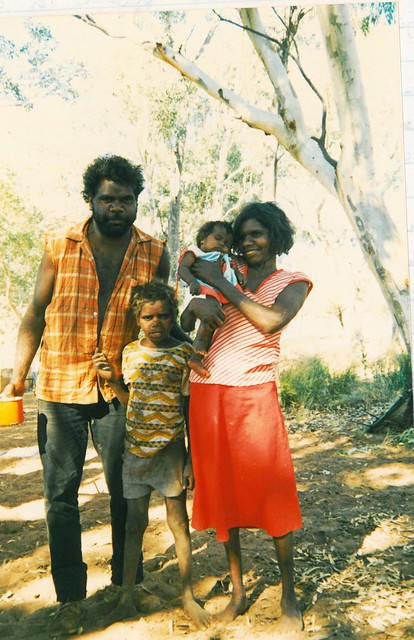Throughout the 19th century, white Australians had no idea of such kinship relations and on several occasions stated that Aboriginals had no religion, no morals and it was even discussed if they were human! In such an un-caring and unjust climate, the original Australians were killed, dispersed, or put into slavery. They had no rights; their land was taken away from them. Uncaring missionaries took their Tjukurrpa away and they felt lost and became strangers or prisoners of the new rulers of the land; the same land that they loved and had cared for more than 50,000 years.
In such an un-caring and un-loving environment, families were torn apart, missions brainwashed Aboriginal children. Aboriginals had to have a very strong personality in those days not to be affected by the white spell that was cast over them. The result – an outlawed Aboriginal society living on the outskirts of white society. And as nobody really cared about their health, education social and spiritual needs, the results were: low life expectancy, high child mortality, poverty, illiteracy, etc.
Highly demoralised by this white racism they tried to escape in drunkenness or were (are) forced into suicide.
But all was not lost. Since the 1970’s, more and more white people have rejected this behavior. They did care and wanted to love their Aboriginal fellow countrymen. They were genuinely interested in their culture and their religion and in their way of life.
It was not until the sixties and seventies with some early exceptions in the thirties that anthropologists started to study the complex structure of the society of the original Australians. They were among the first white people to show genuine respect, love and care. Slowly white people started to listen to these scientists. And most white Australian started to see the damage caused by their society to the Aboriginal people.
This coincided with a new feeling amongst some of the Aboriginal people who wanted to take life into their own hands and saw that they were the only ones who could really change their miserable situation.
They had to cross tribal boundaries and had to unite. They used the Latin word Aboriginal (meaning original inhabitant) for this. This Aboriginal movement demanded land rights, so they would be able to go back to their traditional tribal lands to start repairing their society. The white cities with alcohol and other drugs is obviously the wrong environment to rebuild black society and traditions.
The Federal Australian Government passed the Land rights Act in 1976. As no white person had yet claimed (!) the Central and Western Deserts, this crown land became the first land claimed by the original inhabitants: the Pitjantjatjara people. Nganyinta played a leadership role in the movement. In 1981, the Pitjantjatjara Land Right Act was passed and 102,630 km2 was given in freehold to the Anangu. At present, some 150 traditional family groups have settled back on their own land.
One of these communities is Angatja. Here lives the remarkable woman Nganyinta. She is in her mid-sixties and had not seen white men until she was 10 years. At that age, she went to the Mission School at Ernabella, some 200 km away from her home at Angatja. She was very fortunate because the people at the Mission accepted the spiritual and cultural life of the Pitjantjatjara people. This proved to be very fortunate and because of this she always kept a positive impression of the white men.
It was Nganyinta’s dream to go back to her own tribal land, not only for cultural reasons but also very much to prevent her children from petrol sniffing and alcohol. She saw how her children and other children were affected by that. It was also Nganyinta who took the initiative to organise a cross cultural experiment. She wanted to share her values of life reflected in Angatja with white people. And she hoped that white people would be interested in this and would be able to share the good things of the white society with her people
A lot of paperwork was necessary to get it off the ground. Black and white bureaucrats were very skeptical when Greg and Diane Snowden-James tried to bring Njanyinta’s idea into practice. Diane and Greg had both worked for over ten years as community workers with the Anangu. They speak their language, understand their traditions, and are respected by both white and black people. In 1987, the cross-cultural experiment was ratified by the Pitjantjatjara Land Council.
Together with fifteen other white people I participated in the expedition in October 1988. When we arrived at the border of the land of the Anangu, we were asked by Greg to get out of the car and to “feel” the country, so the country could welcome us. When I sat on a huge rock formation overlooking the country, I could feel tat something important was going to happen.
